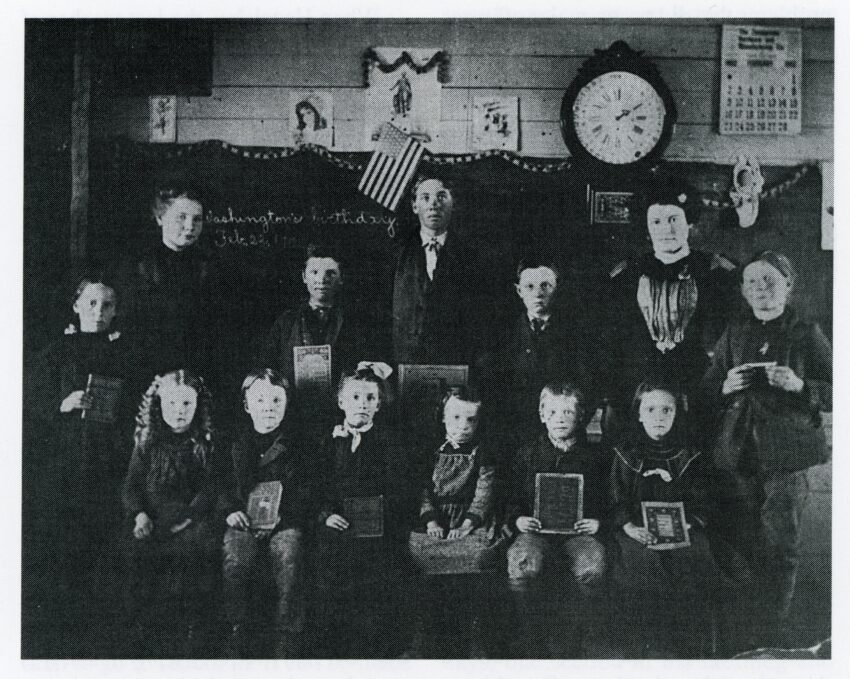[Excerpt from Dodge City and Ford County, Kansas 1870-1920 Pioneer Histories and Stories. Copyright Ford County Historical Society, Inc. All Rights reserved.]
The West Hopewell School, nine and one-half miles south of Dodge City, was typical of the rural schools of Ford County in the late 1800s and early 1900s. Good Old Golden Rule Days, compiled by the book committee of the communities south of Dodge City, says that School District No. 54 was organized in 1887. There are no records, however, to indicate any teachers were hired or any pupils attended classes there until 1894.
According to Adams family records – and due to the influence of Mrs. WT. (Annie) Adams – school was first held in a room of the Adams home during the 1894-95 term. The oldest Adams son, Arthur, was the teacher. The family marks the date by the birth of triplets Mary, Leroy and Leotie in the house during a school day, November 23, 1894.
The name West Hopewell was suggested by Mrs. Thomas W. (Ella) Bell: “Hopewell” because she had attended a church by that name when she was a child in Iowa, and “West” because she had come west to a new home. Mrs. Bell also organized a West Hopewell Sunday School. It was held in the school building and she acted as its superintendent for many years.
Teaching in a rural school offered a challenge to even the most creative teacher. With children whose ages could range from six to 18, the teacher had to deal with lessons for as many as eight different grades simultaneously. Each class period was only 10 or 15 minutes in length. Class periods usually began with first grade reading. Upper-grade subjects such as arithmetic and government were also taught early in the day because they were considered the most difficult. As each grade level was given time to recite, other students studied lessons assigned the day before. Older pupils knew what was expected of them because they had gone through the lower grades in the rural school.

The recitation period was used to test the children on their daily studies. Every class had a recitation time each day. Sometimes a child’s work could be checked at his desk to save time, but if there were several in the class, the teacher called them to the recitation bench at the front of the room. Memorization was an important part of the learning process in those days.
Textbooks used in the West Hopewell School, as well as all schools in the state, were mandated by the Kansas State Board of Education. In some school districts, the parents were expected to supply their children’s books, but other districts purchased books and supplies out of their allotted tax money. The teacher was supplied with a state Course of Study that told how many pages needed to be covered by each grade level each day. But the textbook alone was not enough, so teachers were responsible for making up their own seat work to supplement the text. Many used flash cards to help in teaching the alphabet, phonics, multiplication tables, etc. Bimonthly examinations were mailed out by the state, so that the teacher and students could evaluate how well they were covering the assigned materials. Seventh and eighth graders had to take tests at the end of the school year – tests also sent out by the state. Seventh graders took tests over geography, physiology and Kansas history. Eighth graders were tested in reading, classics, spelling, agriculture, writing, arithmetic, language and grammar, U.S. history and civil government. No grade below 60 was accepted, and an average of 80 or more was required for graduation. Students wanting to go to high school had to pass these tests.
Discipline and control in the classroom were essential for students to learn, especially since there were so many different things happening at once. However, teachers seldom had serious discipline problems. Of the problems that did occur, major offenses were throwing paper wads, dipping a pigtail (end of a long braid) in an inkwell, flying paper airplanes or whispering. Chewing gum was seen as “serious” and very “ill-mannered”!
In the 1930s, West Hopewell pupils looked forward to the annual tour of Dodge City. There they visited the Beeson Museum where each student paid 10 cents admission. Next, they went to the Fairmont Creamery where the highlight at the end of the tour was a free ice cream cone. Then it was on to the Dr. Pepper plant where they received more free samples. Other places on their visit included Ham Bell’s pet shop, the jail and the historical markers around town. The students always enjoyed going to Wright Park to eat their sack lunches.
Other special days were planned throughout the school year. On achievement day, three of the area schools – West Hopewell, South Hopewell and Concord – gathered for games and plays with actors and costumes. Students enjoyed sharing their accomplishments with their parents and the other schools. On track meet day, one school was pitted against another in different races and field events. Good sportsmanship was stressed heavily and when the day was over, winners and losers were still friends.
When Hazel Jay, the last teacher of West Hopewell School, closed the door on the final day of the 1940-41 term, the old school building was deserted. One could almost hear it give a final sigh and whisper, “I’m old now, deserted and forlorn. My time is limited. I have outlived my usefulness. I am not needed anymore. I have served my community well. I once was a schoolhouse, West Hopewell District No. 54.”
Dodge City and Ford County, Kansas 1870-1920 Pioneer Histories and Stories is available for purchase from the Ford County Historical Society.

